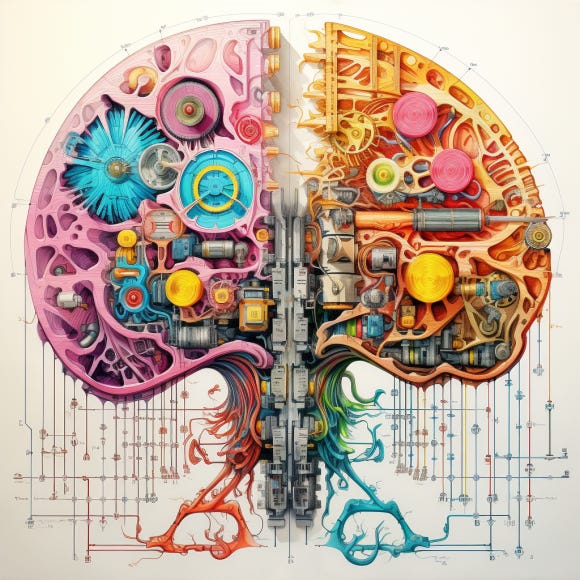Minds and Machines: Decoding the Enigma of Learning: Part 1
An In-Depth Analysis of Human and Artificial Cognitive Processes
Introduction
Welcome to the first part of our two-part series focusing on the similarities and differences between human and artificial intelligence. In this edition, I will be laying the groundwork for our discussion by exploring the intricacies of human learning. This foundation will serve as a basis for understanding the unique aspects of human cognition and how it relates to the world of AI.
In the upcoming second part, I am thrilled to introduce my co-author, the brilliant Alejandro Piad Morffis. Alejandro's expertise in machine learning and natural language processing will bring a fresh perspective to the table, complementing the insights from the fields of education and cognitive science. His section promises to be truly mind-blowing, offering a glimpse into the exciting possibilities that AI holds for the future of education.
Consider subscribing to Alejandro’s most popular Substack:
Let me just say, dear readers, you are in for a treat when you read Alejandro's section in the upcoming second part of this series. His insights are nothing short of groundbreaking, and I guarantee that you will be as astounded as I was when I first read his contribution. Alejandro's expertise in machine learning and natural language processing has opened up entirely new perspectives on the potential impact of AI on education.
When I first read Alejandro’s section, whole new educational vistas opened up before my eyes! Imagine a world where language learning is transformed by probabilistic equations that uncover the hidden semantic structures connecting different languages.
Picture a language arts curriculum that leverages these equations to assign reading levels based on complex probabilistic vectors, taking into account nuanced concepts like ambiguity and double voicing. And envision a revolutionary theory of knowledge that seamlessly integrates classroom insights, brain science, and the probabilistic features of language that are being unveiled through the rapid development of AI technology.
But before we dive into the world of machine learning, it is crucial to establish a solid understanding of human learning. In this first part, we will explore various learning theories, from the foundational perspective of Aristotle to the elusive definition of learning itself. We will also identify common grounds in learning theories, providing a comprehensive overview of how humans acquire knowledge and skills.
By laying this groundwork, we aim to create a context in which the similarities and differences between human and machine learning can be meaningfully explored. The insights gained from understanding human cognition will serve as a lens through which we can interpret and appreciate the advancements in artificial intelligence.
So, join me on this fascinating journey as we unravel the complexities of human learning, setting the stage for a thought-provoking comparison with the world of AI in the forthcoming second part of our series. Stay tuned for Alejandro's illuminating contributions, which promise to challenge our assumptions and inspire new ways of thinking about the future of education and the human mind.
If you didn’t have a chance to read our first series on human cognition and artificial intelligence, consider checking it out before digging into the following the material.
Neurons to Networks: Bridging Human Cognition and Artificial Intelligence, Part 1
From Information to Knowledge Greetings, Educating AI Community!!! In 2024, Educating AI will continue unveiling its a novel approach to seamlessly blend AI technologies into today’s writing classrooms, emphasizing the pivotal distinction between “information” and “knowledge.”
Neurons to Networks: Bridging Human Cognition and Artificial Intelligence, Part 2
Thank you all for the incredible support for Part 1 of this series! I'm truly convinced that we have one of the most passionate and dedicated Education x AI readerships currently out there. A special shoutout to Alejandro Piad Morffis for his exceptional contribution to
Part 1: Human Learning
“Theories of Human Learning: From Aristotle to Information Processing”
Throughout this section, I will answer the following four questions:
How do different learning theories contribute to our understanding of the nature of human learning?
What are the unique characteristics of human learning that distinguish it from machine learning?
How can insights from human learning theories inform the development of artificial intelligence systems?
What are the implications of understanding human learning for the future of education and the advancement of AI?
1. The Foundational Perspective of Aristotle
Aristotle, a seminal figure in philosophical thought, differentiates between a theory and its subject. In his empirical philosophy, he asserts that the subject itself holds more significance than any theories about it. This notion is particularly relevant when comparing human and machine learning, as both approaches aim to untangle the intricate process of learning. While various theories attempt to explain the mechanics of learning, it is essential to consider the subject itself – the learner, whether human or machine – and the unique characteristics that shape their learning experiences. As our understanding of the human brain and artificial intelligence has deepened, so too have these theories evolved, refining both their insights and the practices they inspire.
2. The Elusive Definition of Learning
Defining "learning" has sparked intense debate in both educational and artificial intelligence circles. Säljö's 1979 survey revealed five distinct perspectives on human learning:
Learning as an increase in knowledge.
Learning as memorization.
Learning as acquiring facts, skills, and methods.
Learning as making sense of or abstracting meaning.
Learning as reinterpreting knowledge to understand reality differently.
Paul Ramsden, in 1992, observed that definitions 1-3 view learning as a product, while 4-5 see it as a process. Modern educational theories often find learning at the nexus of these two concepts, where acquiring skills leads to new knowledge, and vice versa. Similarly, machine learning approaches can be categorized as either focused on the outcome (e.g., accurately classifying data) or the process (e.g., continuously improving performance through experience). Thus, learning can be broadly defined as a process of acquiring information, knowledge, skills, and competencies, encompassing the full spectrum of Säljö's categories for both human and machine learners.
3. Common Grounds in Learning Theories
Numerous learning theories exist, each with its unique focus: neurological, behavioral, cognitive, constructivist, social, transformative, and more. Andrew P. Johnson, in his Essential Learning Theories, distills some universal truths that apply to both human and machine learning:
Learning is a lifelong endeavor.
Learners are naturally inclined to acquire new knowledge and skills.
Learning can be effortless if the material is interesting or relevant.
Learning aligns effortlessly with natural learning processes.
Learning is cyclical, not linear.
However, it's important to acknowledge that learning often requires effort, whether for humans or machines. A key factor is 'readiness' – not just a lack of knowledge but a state that includes a positive attitude and confidence in the learning process, as Dr. Dan Gartrell defines it.
While machines may not experience psychological states in the same way as humans, the concept of readiness can be applied to ensure that machine learning models are adequately prepared and optimized for their intended tasks. As we delve deeper into the comparison of human and machine learning, these common grounds provide a foundation for understanding the fundamental aspects of learning that may be shared or diverge between the two approaches.
4. Piaget's Cognitive Development Journey
Jean Piaget's theory of cognitive development offers a captivating lens through which to explore the nature of human learning. By envisioning learning as a dynamic odyssey through distinct stages, Piaget illuminates the learner's active role in constructing knowledge through interaction with the environment. As individuals navigate Piaget's stages, they acquire new skills and abilities that allow them to engage with the world in increasingly sophisticated ways, underscoring the notion that learning is an active, transformative journey.
Piaget's theory emphasizes the importance of challenge and disequilibrium in catalyzing cognitive growth. When learners encounter new experiences that do not align with their existing schemas, they are compelled to adapt and reconstruct their understanding, serving as a powerful catalyst for learning and development.
Piaget's theory contributes to a broader discussion of the nature of human learning by illuminating its active, constructive, and developmental character. It reinforces the idea that learning is a complex, multifaceted process that involves the interplay of individual experiences, social interactions, and cognitive processes.
Ultimately, Piaget's insights have had a profound impact on educational practices, inspiring approaches that emphasize active exploration, problem-solving, and the construction of meaning. As we continue to unravel the mysteries of the human brain and body, Piaget's theory remains a valuable framework for conceptualizing the dynamic, transformative nature of learning.
5. Vygotsky: The Social Fabric of Learning
Lev Vygotsky's theory adds a crucial social dimension to our understanding of human learning, emphasizing the collaborative nature of the learning process. His concept of the Zone of Proximal Development (ZPD) highlights the transformative power of learning with others, suggesting that social engagement can push learners beyond their current abilities and facilitate cognitive growth.
Vygotsky's theory complements Piaget's focus on individual cognitive development by recognizing the crucial role of social interactions and cultural contexts in shaping learning experiences. It reminds us that true linguistic understanding is not just a matter of manipulating symbols, but also of engaging with shared meanings and cultural practices.
Vygotsky's insights have informed educational practices that emphasize collaboration, dialogue, and the co-construction of knowledge. As we explore the nature of human learning in the age of artificial intelligence, Vygotsky's theory serves as a powerful reminder of the unique social and cultural dimensions of human cognition, inviting us to create learning experiences that harness the transformative power of social engagement.
6. Information Processing: Decoding Cognitive Mechanics
The Information Processing Model presents a methodical approach to cognition, comparing the mind to a computer. It segments cognitive processing into sensory memory, working memory, and long-term memory, emphasizing learning as an organized integration of information beyond mere fact accumulation.
By drawing parallels between the human mind and a computer, the model provides a structured framework for understanding the mechanisms underlying learning and memory. It highlights the sequential nature of cognitive processing and the importance of attention and rehearsal in transferring information from fleeting sensory impressions to more stable, long-term representations.
The Information Processing Model contributes to a broader discussion of the nature of human learning by providing a systematic, computer-inspired framework for understanding cognitive processes. It complements other learning theories by focusing on the internal mechanisms of information processing and storage.
As we compare human and machine learning, the model serves as a useful reference point for considering the unique strengths and limitations of each approach. While machines can process information rapidly and accurately, the human mind's ability to meaningfully integrate and organize information in long-term memory remains a key distinguishing feature. Understanding these differences can inform the development of artificial intelligence systems that more closely mimic the adaptive, flexible nature of human learning.
7. Learning: The Interplay of Evolution and Ethics
Peter Tse, a neuroscientist, views human learning as a tapestry of perception, evaluation, and action, rooted in evolutionary necessity. He argues that our ancestors' ability to learn and adapt was crucial for survival, underscoring learning as a fundamental part of our physical existence and survival strategy.
This evolutionary perspective on learning highlights the dynamic, interactive nature of the learning process, involving the continual assessment of sensory input, the evaluation of its relevance and meaning, and the selection of appropriate actions in response. It emphasizes the importance of flexibility and adaptability in human cognition, as the ability to learn from experience and adjust one's beliefs and behaviors is essential for survival.
Tse's view contributes to a broader discussion of the nature of human learning by situating it within an evolutionary framework. It complements other learning theories by emphasizing the adaptive, survival-oriented functions of learning and the importance of interaction with the environment.
In the context of this study, Tse's perspective serves as a reminder of the deep biological roots of human cognition. While artificial intelligence systems can exhibit impressive learning capabilities, they are not subject to the same evolutionary pressures and constraints that have shaped human learning over millions of years. Understanding these differences can inform the development of AI systems that are more robust, adaptable, and aligned with human values and goals.
But this is just the beginning. In the upcoming second part of this series, Alejandro Piad Morffis will take us on a captivating journey through the world of machine learning, from the humble beginnings of n-grams to the awe-inspiring power of large language models (LLMs).
Alejandro's expertise in natural language processing and machine learning will guide us through the key concepts and techniques that have made it possible for machines to understand and generate human language with increasing sophistication. His insights will challenge us to rethink our assumptions about language, cognition, and the very nature of intelligence itself.
So, dear readers, stay tuned for an intellectual journey that will expand your horizons and ignite your imagination. Alejandro's section promises to be a landmark contribution to our understanding of the intersection between human and machine learning, bridging the gap between these two fascinating fields of study.
Nick Potkalitsky, Ph.D.
Check out some of my favorite Substacks:

















This also goes to show how narrow the meaning of "learning" is in the machine learning community.
Yet another collab between the dynamic duo? That's what I like to see.
Thanks for the solid background on the theories about human learning. I look forward to the much-hyped AI part by Alejandro!